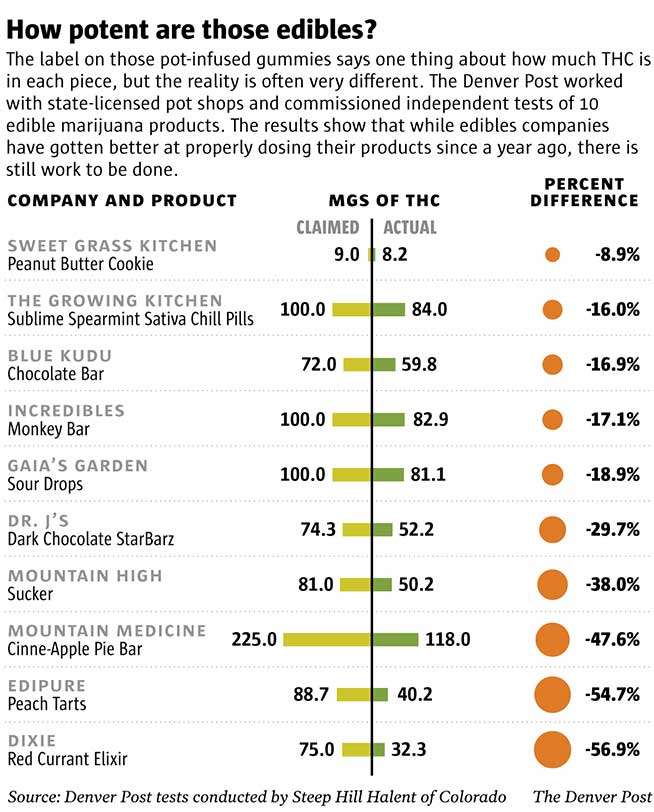The involvement of edibles initially was investigated after Richard Kirk shot and killed his wife, Kristine, at their Denver home in April 2014. But toxicology later showed a small amount of THC in Kirk’s system, and prosecutors now argue that Kirk acted deliberately, saying the drug’s effects weren’t enough to affect Kirk’s grasp on reality. Kirk has pleaded not guilty, and the trial is set for the fall.
As of Feb. 1, all recreational edibles sold in Colorado shops included more explicit on-label instructions such as “The intoxicating effects of this product may be delayed by two or more hours” and “The standardized serving size for this product includes no more than 10 mg.” Goodman purchased his edibles March 21.
Related
“It’s not an exact science” — Lab: Edibles’ potency more accurate than a year ago, still needs work
Watch The Cannabist Show. Follow The Cannabist on Twitter and Facebook
“It was a compliant package, compliant labeling, large enough font for the average person to read and this person chose to ignore the warnings,” Seeb said. “Why is it the responsibility of the shop?”
Understanding edibles
To better understand the complexity of edibles, it makes sense to start with what makes their high so singular, doctors agreed.
“When smoked or vaporized, marijuana’s psychoactive effect begins quickly, peaks quickly and goes away relatively quickly,” said Dr. Alan Shackelford, a Denver medical marijuana doctor who is conducting several studies on cannabis in Israel. “When marijuana is ingested, the absorption rate is much slower and subject to many variables. The onset of effect is slower, the peak is achieved much more slowly and the effect typically lasts much longer.”
The effects of smoking pot often will be felt within minutes; the effects of edible marijuana can take more than an hour or two.
“Edibles go through digestion, and it takes a while for that to happen,” said Dr. Jason Persoff, a nocturnist and assistant professor at the University of Colorado School of Medicine. “That can lead to a sustained high, and it also can have sustained side effects.”

Educational campaigns have emerged around the edibles space in the past year. The nonprofit Smart Colorado campaigned with billboards and a media rush on edibles resembling normal, nonintoxicating candies already on the market. Cannabis trade organizations, including Cannabis Business Alliance and Marijuana Industry Group, made their own pamphlets and websites warning users of edibles’ precarious nature.
The Council on Responsible Cannabis Regulation‘s “First Time 5” campaign questions Colorado’s suggested serving size and encourages novices to start with half of the state-recommended 10-milligram dose.
Thanks to educational campaigns and added regulations, edible marijuana in Colorado is safer now, many say.
“If you look at the implementation of the regulations from this day last year till today,” said the Marijuana Enforcement Division’s Koski, “you could say that we’ve done a lot to make products safer for the public, both through the testing piece and by making edibles intuitively safer for consumers who are new to the consumption of marijuana, making it more clear where the servings exist in those products.”
In early May, the state began its mandatory lab-testing program on recreational edibles, forcing the companies making the infused products to test each batch for potency. The move came a couple of months after The Post published the results of its independent study on edibles potency, which showed wildly varying amounts of actual THC compared with what the products claimed on their labels.
In the 2014 test, four products from edibles company Dr. J’s — each labeled for 100 milligrams of THC — contained only 0.2 to 5 milligrams.
An Incredibles chocolate bar labeled for 100 milligrams of THC actually had 146 milligrams.
Edibles companies fared better in The Post’s new study, conducted by state-licensed lab Steep Hill Halent of Colorado in late March. None of the products tested over their labeled amount of THC, which speaks to the Marijuana Enforcement Division’s strict protocol that any recreational-edible testing higher than 100 milligrams of THC needs to be reworked or destroyed.

While five of the 10 tested products had THC levels that were 30 to 57 percent smaller than what they were labeled for, the other half fell into an acceptable variability range, said Remy Kachadourian, the lab director at Steep Hill Halent.
In Washington state, where recreational pot sales started in July — several months after Colorado’s sales began — “there’s a lot of concern here about edibles, because many people consume edibles today as a way of consuming marijuana,” said Brian Smith, communications director at the Washington State Liquor Control Board, which regulates recreational cannabis there. “If Washington is going to make deeper inroads into the illicit market, these types of products need to be available — because they’re widely available in (Washington’s still-unregulated) medical system.”
While recreational edibles have proved to be popular in Washington, the state hasn’t seen any edibles-related fatalities, Smith said.
National legalization opponent Kevin Sabet estimates there are more negative stories to be told about experiences with edibles.
“It’s probably the tip of the iceberg,” said Sabet, co-founder of Project SAM (Smart Approaches to Marijuana) and director of the Drug Policy Institute at the University of Florida.
“For every story about a death, there are dozens of other stories of near-death experiences that we don’t hear about, of lives that have been directly harmed by allowing these edibles — which take a while to have an effect and have a very strong effect — to be sold in retail stores.”
Ricardo Baca: 303-954-1394, rbaca@denverpost.com or twitter.com/bruvs
